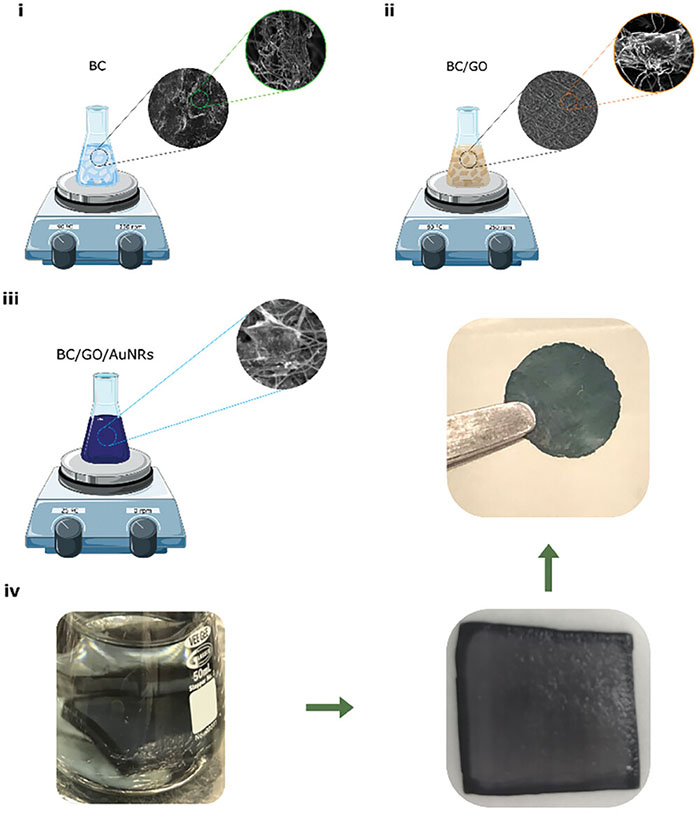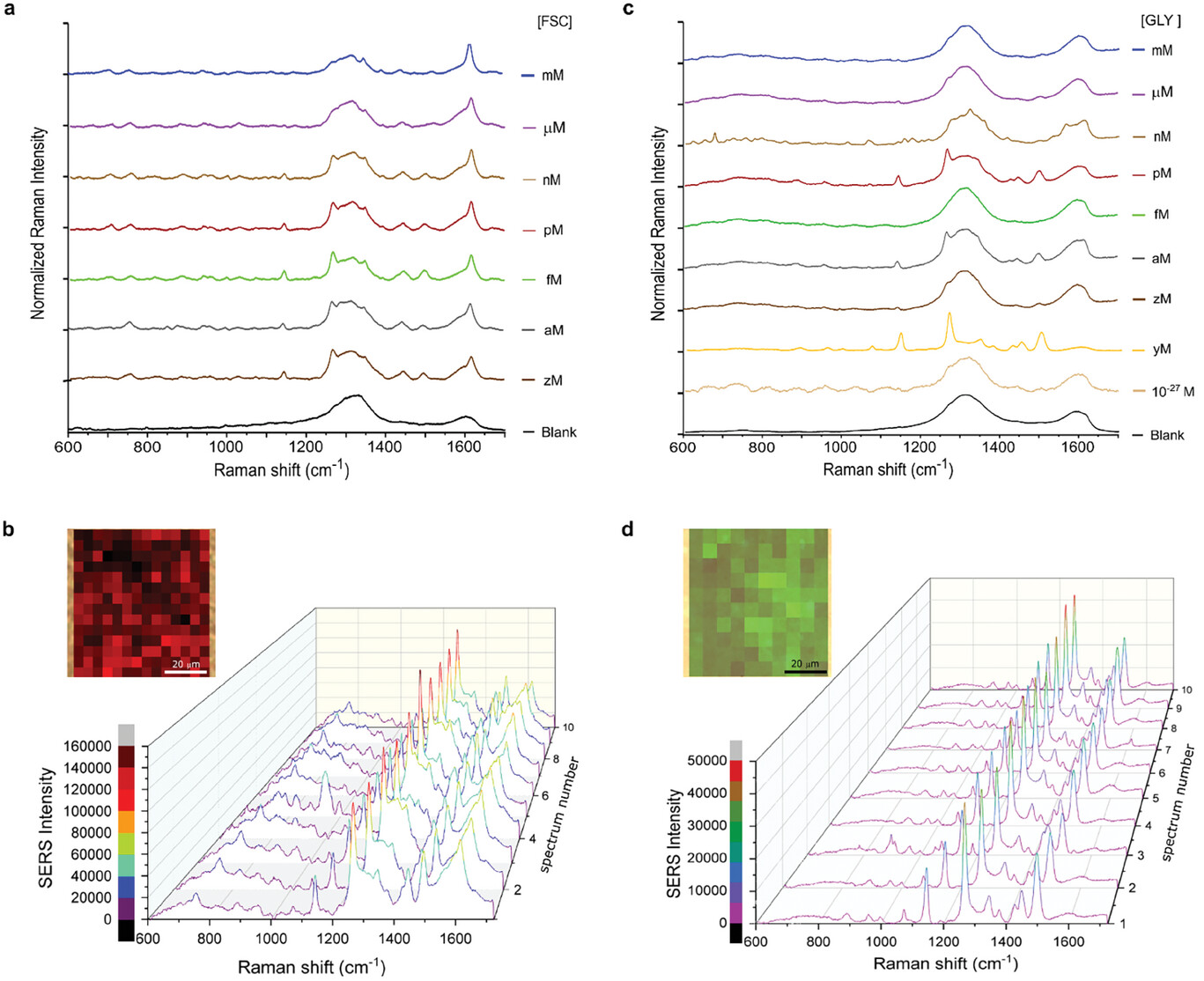| Apr 10, 2024 | |
Ultrasensitive 3D plasmonic web can detect molecules at the yoctomolar level |
|
| (Nanowerk Spotlight) The field of surface-enhanced Raman spectroscopy (SERS) has long held the promise of single-molecule detection, but achieving this level of sensitivity in a reliable and reproducible manner has proven challenging. | |
| SERS relies on the dramatic electromagnetic enhancement that occurs in specific regions known as "hot spots" near metallic nanostructures. However, positioning molecules precisely within these hot spots and ensuring a high density of intense hot spots has been a major hurdle. | |
| Over the years, researchers have explored various strategies to overcome these limitations. Nanomaterials such as nanoparticle aggregates, sharp edges, and engineered nanogaps have been employed to create dense arrays of hot spots. Rationally designed nanogaps have shown improved reproducibility, but their fabrication often requires complex and expensive infrastructure. Surface engineering approaches that control surface wettability have been used to preconcentrate analytes and push detection limits down to the femtomolar range. Yet, the need for a SERS substrate that combines high hot spot density, easy analyte incorporation, and ultrasensitive detection has remained unmet. | |
| A breakthrough has now emerged from the Biophotonic Nanosensors laboratory of Prof. Eden Morales-Narváez and team, who have developed a unique 3D plasmonic web embedded within a flexible biohybrid material. Named 3D-POWER (3D Plasmonic Web Enables Remote Surface Enhanced Raman Spectroscopy), this composite comprises self-assembled layers of graphene oxide interspersed with gold nanorods, all nestled within a matrix of bacterial nanocellulose. | |
| The research has been published in Advanced Science ("Flexible 3D Plasmonic Web Enables Remote Surface Enhanced Raman Spectroscopy"). | |
 |
|
| 3D-POWER fabrication process. i) BC is washed with ultrapure water. ii) BC is added in aGOsuspension.GOis spontaneously self-assembled by layers within BC. iii) BC/GO is added in a suspension of AuNRs. AuNRs are absorbed within BC/GO in this process. iv) 3D-POWER is washed and dried. (Reprinted from doi:10.1002/advs.202402192, CC BY) | |
| "The choice of materials is key to 3D-POWER's exceptional performance," Morales-Narváez tells Nanowerk. "Gold nanorods are known for their strong SERS enhancement, outperforming their spherical counterparts. Graphene oxide, with its planar aromatic structure, helps anchor organic molecules via π-π stacking interactions. It also amplifies the SERS effect through charge transfer with the analyte.Finally, the bacterial nanocellulose scaffold provides a biocompatible structure that can soak up analyte molecules like a sponge." | |
| But, as he points out, what truly sets 3D-POWER apart is its ability to function as a plasmonic web that not only concentrates light at specific points but also transmits the plasmonic field throughout the material. | |
| Theoretical simulations revealed that 3D-POWER can capture light within a small volume and generate a far-reaching plasmonic network. This enables a remarkable feat: remote SERS sensing, where analytes can be detected even if they are not directly within the laser focus. | |
| The researchers backed up this claim with compelling experimental data. By depositing just a handful of fluorescein molecules onto 3D-POWER, they could detect the SERS signal up to 700 µm away from the original drop location. Astonishingly, even with a mere 10 molecules deposited, the SERS spectrum was detectable across the entire millimeter-sized substrate. | |
| The sensitivity achieved by 3D-POWER is nothing short of extraordinary. For fluorescein, the researchers obtained an analytical enhancement factor of up to 8 × 1016. When testing the pesticide glyphosate, the detection limit plummeted to the yoctomolar level (10-24 M) – tantalizingly close to single-molecule detection and orders of magnitude better than conventional SERS substrates. | |
| Understanding yoctomolar sensitivity can be challenging due to the incredibly small scale it represents. A yoctomolar (yM) concentration is equivalent to one septillionth (1/1024) of a mole per liter, which translates to detecting mere hundreds of molecules in a vast quantity of liquid. To put this into a more comprehensible perspective, imagine detecting a single molecule in approximately 1.66 million Olympic-sized swimming pools (each containing 2.5 million liters of water). This staggering level of sensitivity enabled by 3D-POWER technology allows for the identification of specific molecules with unparalleled precision, even in extremely dilute samples. | |
| To showcase its real-world utility, the researchers put 3D-POWER to the test with food samples and bodily fluids. By simply rubbing the flexible substrate against the surface of fruits and vegetables, they could identify trace pesticide residues. SERS analysis of sweat and sebum samples revealed the presence of various metabolites, hinting at applications in non-invasive biofluid monitoring. | |
 |
|
| 3D-POWER as a SERS substrate. a) SERS spectra of 3D-POWER impregnated with FITC (FSC) at different concentrations (from mm to zm). b) Representative SERS spectra and SERS mapping (relative intensity of the peak at 1616 cm−1) offered by 3D-POWER impregnated with [FSC] = 10−21 m (zm). c) SERS spectra of 3D-POWER impregnated with Glyphosate (GLY) at different concentrations (from mm to ym). d) Representative SERS spectra and SERS mapping (relative intensity of the peak at 1500 cm−1) offered by 3D-POWER impregnated with [GLY] = 10−24 m (ym). Each spectrum represents the average of at least one hundred spectra recorded onto an area of 2500 µm2 of 3D-POWER. All Raman measurements were performed using an excitation wavelength 785 nm, power, 0.08 mW, and exposure time, 2 s, size of the spot = 1.2 µm, and number of acquisitions, 10. (Reprinted from doi:10.1002/advs.202402192, CC BY) | |
| The development of 3D-POWER marks a significant leap forward for SERS technology. Its ability to enable remote sensing and achieve yoctomolar sensitivity in a flexible, biocompatible format opens up exciting new possibilities for ultrasensitive chemical analysis and single-molecule detection. | |
| "The plasmonic web concept at the heart of 3D-POWER is a key innovation," Morales-Narváez concludes. "By transmitting the SERS signal through an extended 3D network, it overcomes the limitations of traditional surface-based SERS substrates that require precise positioning of analytes within nanoscale hot spots. This remote sensing capability expands the potential applications of SERS in fields such as environmental monitoring, food safety testing, and biomedical diagnostics." | |
| As with any cutting-edge technology, further research will be needed to fully optimize and understand the capabilities of 3D-POWER. Quantitative analysis remains a challenge due to the remote sensing mechanism, and strategies for specific analyte capture and signal enhancement within the 3D web could boost performance even further. | |
| Nevertheless, the advent of 3D-POWER represents an exciting milestone in the ongoing quest to realize the full potential of single-molecule SERS. As research in this area forges ahead, we can exppect to see new innovations that build upon the concept of extended plasmonic networks. With ever-increasing control over light-matter interactions at the nanoscale, SERS and related techniques are poised to play an increasingly pivotal role in chemical analysis and sensing in the years to come. | |
 By
Michael
Berger
– Michael is author of three books by the Royal Society of Chemistry:
Nano-Society: Pushing the Boundaries of Technology,
Nanotechnology: The Future is Tiny, and
Nanoengineering: The Skills and Tools Making Technology Invisible
Copyright ©
Nanowerk LLC
By
Michael
Berger
– Michael is author of three books by the Royal Society of Chemistry:
Nano-Society: Pushing the Boundaries of Technology,
Nanotechnology: The Future is Tiny, and
Nanoengineering: The Skills and Tools Making Technology Invisible
Copyright ©
Nanowerk LLC
|
|
|
Become a Spotlight guest author! Join our large and growing group of guest contributors. Have you just published a scientific paper or have other exciting developments to share with the nanotechnology community? Here is how to publish on nanowerk.com. |
|
